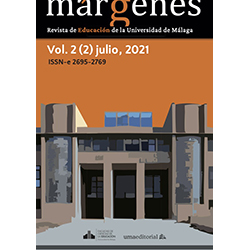Qualitative Quality: Eight “Big-Tent” Criteria for Excellent Qualitative Research
DOI:
https://doi.org/10.24310/mgnmar.v2i2.12937Keywords:
qualitative pedagogy, rigor, credibility, criteria, ethics, evaluationAbstract
This article presents a model for quality in qualitative research that is uniquely expansive, yet flexible, in that it makes distinctions among qualitative research’s means (methods and practices) and its ends. The article first provides a contextualization and rationale for the conceptualization. Then the author presents and explores eight key markers of quality in qualitative research including (a) worthy topic, (b) rich rigor, (c) sincerity, (d) credibility, (e) resonance, (f) significant contribution, (g) ethics, and (h) meaningful coherence. This eight-point conceptualization offers a useful pedagogical model and provides a common language of qualitative best practices that can be recognized as integral by a variety of audiences. While making a case for these markers of quality, the article leaves space for dialogue, imagination, growth, and improvisation.
Downloads
Metrics
Publication Facts
Reviewer profiles N/A
Author statements
Indexed in
-
—
- Academic society
- N/A
- Publisher
- Universidad de Málaga
References
Abbott, A. (2004). Methods of discovery: Heuristics for the social sciences. New York: W.W. Norton.
Altheide, D. L., & Johnson, J. M. (1994). Criteria for assessing interpretive validity in qualitative research. In N. K. Denzin & Y. S. Lincoln (Eds.), Handbook of qualitative research (2nd ed., pp. 485-499). Newbury Park, CA: Sage.
Atkinson, E. (2004). Thinking outside the box: An exercise in heresy. Qualitative Inquiry, 10, 111-129.
Bloor, M. (2001). Techniques of validation in qualitative research: A critical commentary. In R. M. Emerson (Ed.), Contemporary field research (pp. 383-396). Prospect Heights, IL: Waveland Press.
Bochner, A. P. (2000). Criteria Against Ourselves. Qualitative Inquiry, 6(2), 266–272. https://doi.org/10.1177/107780040000600209
Bourne, M. C. (2002). Food texture and viscosity: Concept and measurement (2nd ed.). New York: Academic Press.
Cannella, G. S., & Lincoln, Y. S. (2004). Dangerous Discourses II: Comprehending and Countering the Redeployment of Discourses (and Resources) in the Generation of Liberatory Inquiry. Qualitative Inquiry, 10(2), 165–174. https://doi.org/10.1177/1077800404262988
Charmaz, K. (2005). Grounded theory in the 21st century: Applications for advancing social justice studies. In N. K. Denzin & Y. S. Lincoln (Eds.), The sage handbook of qualitative research (3rd ed., pp. 507-535). Thousand Oaks, CA: Sage.
Cheek, J. (2007). Qualitative Inquiry, Ethics, and Politics of Evidence: Working Within These Spaces Rather Than Being Worked Over by Them. Qualitative Inquiry, 13(8), 1051–1059. https://doi.org/10.1177/1077800407308227
Christians, C. G. (2005). Ethics and politics in qualitative research. In N. K. Denzin & Y. S. Lincoln (Eds.), The Sage handbook of qualitative research (3rd ed., pp. 139-164). Thousand Oaks, CA: Sage.
Creswell, J. W. (2007). Qualitative inquiry and research design: Choosing among five traditions (2nd ed.). Thousand Oaks, CA: Sage.
Creswell, J. W., & Miller, D. L. (2000). Determining Validity in Qualitative Inquiry. Theory into Practice, 39(3), 124–130. http://doi.org/10.1207/s15430421tip3903_2
Cunliffe, A. L. (2011). Crafting Qualitative Research: Morgan and Smircich 30 Years On. Organizational Research Methods, 14(4), 647–673. https://doi.org/10.1177/1094428110373658
Dadds, M. (2008). Empathetic validity in practitioner research. Educational Action Research, 16(2), 279–290. http://doi.org/10.1080/09650790802011973
Denzin, N. K. (1978). Sociological methods: A sourcebook (2nd ed.). New York: McGraw Hill.
Denzin, N. K. (1997). Interpretive ethnography: Ethnographic practices for the 21st century. Thousand Oaks, CA: Sage.
Denzin, N. K. (2008). The new paradigm dialogs and qualitative inquiry. International Journal of Qualitative Studies in Education, 21(4), 315–325. http://doi.org/10.1080/09518390802136995.
Denzin, N. K., & Giardina, M. D. (2008). Qualitative inquiry and the politics of evidence. Walnut Creek, CA: Left Coast Press.
Denzin, N. K., & Lincoln, Y. S. (2005). Introduction: The discipline and practice of qualitative research. In N. K. Denzin & Y. S. Lincoln (Eds.), The Sage handbook of qualitative research (3rd ed., pp. 1-32). Thousand Oaks, CA: Sage.
Dreyfus, H. L., Dreyfus, S. E., & Athanasiou, T. (1986). Mind over machine: The power of human intuition and expertise in the era of the computer. New York: Free Press.
Eisenber, E. M. (1990). Jamming: Transcendence Through Organizing. Communication Research, 17(2), 139–164. https://doi.org/10.1177/009365090017002001Ellingson, L. L. (2008). Engaging crystallization in qualitative research. Thousand Oaks, CA: Sage.
Ellis, C. (1991). Sociological Introspection and Emotional Experience. Symbolic Interaction, 14(1), 23–50. http://doi.org/10.1525/si.1991.14.1.23
Ellis, C. (1995). Final negotiations. Philadelphia: Temple University Press.
Ellis, C. (2007). Telling Secrets, Revealing Lives: Relational Ethics in Research With Intimate Others. Qualitative Inquiry, 13(1), 3–29. https://doi.org/10.1177/1077800406294947
Ellis, C., & Bochner, A. P. (2000). Autoethnography, personal narrative, reflexivity. In N. K. Denzin & Y. S. Lincoln (Eds.), Handbook of qualitative research (2nd ed., pp. 733-768). Thousand Oaks, CA: Sage.
Emerson, R. M., Fretz, R., & Shaw, L. (1995). Writing ethnographic fieldnotes. Chicago: University of Chicago Press.
Fine, G. A. (1993). TEN LIES OF ETHNOGRAPHY: Moral Dilemmas of Field Research. Journal of Contemporary Ethnography, 22(3), 267–294. https://doi.org/10.1177/089124193022003001
Fine, M., Weis, L., Weseen, S., & Wong, L. (2000). For whom? Qualitative research, representations, and social responsibilities. In N. K. Denzin & Y. S. Lincoln (Eds.), Handbook of qualitative research (2nd ed., pp. 107-131). Thousand Oaks, CA: Sage.
Fletcher, J. (1966). Situation ethics: The new morality. Louisville, KY: Westminster John Knox Press.
Fox, R. (2007). Skinny Bones #126-774-835-29: Thin Gay Bodies Signifying a Modern Plague. Text and Performance Quarterly, 27(1), 3–19. http://doi.org/10.1080/10462930601045956
Geertz, C. (1973). The interpretation of cultures: Selected essays. New York: Basic Books.
Glaser, B. G., & Strauss, A. L. (1967). The discovery of grounded theory. New York: Aldine de Gruyter.
Golafshani, N. (2003). Understanding Reliability and Validity in Qualitative Research. The Qualitative Report, 8(4), 597-606. https://doi.org/10.46743/2160-3715/2003.1870
González, M. C. (2000). The Four Seasons of Ethnography: a creation-centered ontology for ethnography. International Journal of Intercultural Relations, 24(5), 623–650. http://doi.org/10.1016/s0147-1767(00)00020-1
Guba, E. G., & Lincoln, Y. S. (1989). Fourth generation evaluation. Newbury Park, CA: Sage.
Guba, E. G., & Lincoln, Y. S. (2005). Paradigmatic controversies, contradictions, and emerging confluences. In N. K. Denzin & Y. S. Lincoln (Eds.), The Sage handbook of qualitative research (3rd ed., pp. 191-216). Thousand Oaks, CA: Sage.
Gunasekaran, S., & Ak, M. M. (2002). Cheese rheology and texture. Boca Raton, FL: CRC Press.
Hatch, J. A. (2006). Qualitative studies in the era of scientifically?based research: musings of a former QSE editor. International Journal of Qualitative Studies in Education, 19(4), 403–407. http://doi.org/10.1080/09518390600790308
Holman Jones, S. (2005). Autoethnography: Making the personal political. In Denzin, N. K. & Y. S. Lincoln (Eds.), The sage handbook of qualitative research (3rd ed., pp. 763-791). Thousand Oaks, CA: Sage.
Krizek, R. L. (2003). Ethnography as the excavation of personal narrative. In R. P. Clair (Ed.), Expressions of ethnography: Novel approaches to qualitative methods (pp. 141-151). New York: State University of New York.
Lather, P. (1986). Issues of validity in openly ideological research: Between a rock and a soft place. Interchange, 17(4), 63-84. Lather, P. (1993). Fertile obsession: Validity after poststructuralism. Sociological Quarterly, 34, 673-693.
Lather, P. (2004). This is Your Father’s Paradigm: Government Intrusion and the Case of Qualitative Research in Education. Qualitative Inquiry, 10(1), 15–34. https://doi.org/10.1177/1077800403256154
LeGreco, M., & Tracy, S. J. (2009). Discourse Tracing as Qualitative Practice. Qualitative Inquiry, 15(9), 1516–1543. https://doi.org/10.1177/1077800409343064
Lincoln, Y. S., & Guba, E. G. (1985). Naturalistic inquiry. Beverly Hills, CA: Sage.
Lindemann, K. (2010). Cleaning Up My (Father’s) Mess: Narrative Containments of “Leaky” Masculinities. Qualitative Inquiry, 16(1), 29–38. https://doi.org/10.1177/1077800409350060
Lindlof, T. R., & Taylor, B.C. (2002). Qualitative communication research methods (2nd ed.). Thousand Oaks, CA: Sage.
Martin, J. (1990). Deconstructing organizational taboos: The suppression of gender conflict in organizations. Organizational Science, 1, 339-359.
Miles, M. B., & Huberman, A. M. (1994). Qualitative Data Analysis. Thousand Oaks, CA: Sage.
Murray, S. D. (1971). That’s interesting! Towards a phenomenology of sociology and a sociology of phenomenology. Philosophy of the Social Sciences, 1, 309-344.
Richardson, L. (2000). Evaluating Ethnography. Qualitative Inquiry, 6(2), 253–255. https://doi.org/10.1177/107780040000600207
Richardson, L. (2000b). Writing: A method of inquiry. In N. K. Denzin & Y. S. Lincoln (Eds.), Handbook of qualitative research (2nd ed., pp. 923-948). Thousand Oaks, CA: Sage.
Ronai, C. R. (1995). Multiple reflections of child sex abuse: An argument for a layered account. Journal of Contemporary Ethnography, 23, 395-426.
Sales, B. D., & Folkman, S. (2000). Ethics in research with human participants. Washington, DC: American Psychological Association
Scarduzio, J. A., & Geist-Martin, P. (2008). Making Sense of Fractured Identities: Male Professors’ Narratives of Sexual Harassment. Communication Monographs, 75(4), 369–395. http://doi.org/10.1080/03637750802512363
Schutz, A. (1967). The phenomenology of the social world. Evanston, IL: Northwestern University Press.
Schwandt, T. A. (1996). Farewell to criteriology. Qualitative Inquiry, 2, 58-72.
Scott, R., Robinson, R. K., & Wilbey, R. A. (1998). Cheesemaking practice. Gaithersburg, MD: Aspen.
Seale, C. (1999). Quality in qualitative research. Qualitative Inquiry, 5, 465-478.
Stake, R. E., & Trumbull, D. J. (1982). Naturalistic generalizations. Review Journal of Philosophy and Social Science, 7(1-2), 1-12.
Stenbacka, C. (2001). Qualitative research requires quality concepts of its own. Management Decision, 39(7), 551–556. http://doi.org/10.1108/eum0000000005801
Tillmann-Healy, L. M. (2003). Friendship as Method. Qualitative Inquiry, 9(5), 729–749. https://doi.org/10.1177/1077800403254894
Tracy, K. (1995). Action-Implicative Discourse Analysis. Journal of Language and Social Psychology, 14(1–2), 195–215. https://doi.org/10.1177/0261927X95141011
Tracy, S. J. (2000). Becoming a Character for Commerce: Emotion Labor, Self-Subordination, and Discursive Construction of Identity in a Total Institution. Management Communication Quarterly, 14(1), 90–128. https://doi.org/10.1177/0893318900141004
Tracy, S. J. (2004). The Construction of Correctional Officers: Layers of Emotionality Behind Bars. Qualitative Inquiry, 10(4), 509–533. https://doi.org/10.1177/1077800403259716
Tracy, S. J. (2007). Taking the Plunge: A Contextual Approach to Problem-Based Research. Communication Monographs, 74(1), 106–111. http://doi.org/10.1080/03637750701196862
Tracy, S. J., Lutgen-Sandvik, P., & Alberts, J. K. (2006). Nightmares, Demons, and Slaves: Exploring the Painful Metaphors of Workplace Bullying. Management Communication Quarterly, 20(2), 148–185. https://doi.org/10.1177/0893318906291980
Tracy, S. J., & Rivera, K. D. (2009). Endorsing Equity and Applauding Stay-at-Home Moms: How Male Voices on Work-Life Reveal Aversive Sexism and Flickers of Transformation. Management Communication Quarterly, 24(1), 3–43. http://doi.org/10.1177/0893318909352248
Tracy, S. J., & Scott, C. (2006). Sexuality, Masculinity, and Taint Management Among Firefighters and Correctional Officers: Getting Down and Dirty With “America’s Heroes” and the “Scum of Law Enforcement.” Management Communication Quarterly, 20(1), 6–38. https://doi.org/10.1177/0893318906287898
Van Maanen, J. (1988). Tales of the field: On writing ethnography. Chicago: University of Chicago Press.
Weick, K. E. (2007). The Generative Properties Of Richness. Academy of Management Journal, 50(1), 14–19. http://doi.org/10.5465/amj.2007.24160637
Winter, G. (2000). A Comparative Discussion of the Notion of 'Validity' in Qualitative and Quantitative Research. The Qualitative Report, 4(3), 1-14. https://doi.org/10.46743/2160-3715/2000.2078
Downloads
Published
How to Cite
Issue
Section
License
The editorial team of Márgenes supports an open Access policy of scientific knowledge. apostamos claramente por una política de acceso abierto del conocimiento científico (see Berlin Declaration).
Authors with work published in this journal accept the following conditions:
- This journal provides immediate free access to its content under the principle of making research freely available to the public. All contents published in Márgenes are subject to the Creative Commons Reconocimiento-SinObraDerivada 4.0 Internacional
It is the responsibility of the authors to obtain the necessary permissions of the images that are subject to copyright.
Authors whose contributions are accepted for publication in this journal will retain the non-exclusive right to use their contributions for academic, research and educational purposes, including self-archiving or deposit in open-access repositories of any kind.
The electronic edition of this magazine is edited by the Editorial of the University of Malaga (UmaEditorial), being necessary to cite the origin in any partial or total reproduction.
- Authors can enter into other additional independent contractual agreements for the non-exclusive distribution of the version of the article published in this journal (e.g. including it in an institutional repository or publishing it in a book) on the condition that they clearly indicate that the work was originally published in this journal.
- Authors are allowed and recommended to publish their work on the Internet (for example on institutional and personal websites), before and after the publication, as this could lead to constructive exchanges and a more extensive and quick circulation of published works (see The Effect of Open Access).















